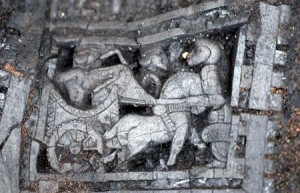 WEST KAZAKHSTAN REGION – The “Golden Princess” or Altyn Hanshaiym found in West Kazakhstan’s Terektin District in 2012 has now been confirmed as one of the oldest tombs discovered in the country.
WEST KAZAKHSTAN REGION – The “Golden Princess” or Altyn Hanshaiym found in West Kazakhstan’s Terektin District in 2012 has now been confirmed as one of the oldest tombs discovered in the country.
The tomb dates back to the early Sarmatian period (fourth and fifth centuries BC) and is considered to be comparable in importance and value to the “Golden Warrior” discovered in 1969 in Issyk in the south-eastern part of the country. In the Golden Princess’s mound, remains of a woman of noble birth were found. She was probably a priestess, judging by the method of burial: there were about 100 gold ornaments and ritual objects found with her. For archaeologists, of special value was her comb.
According to archaeologists, the well-preserved comb with drawings is a storehouse of valuable information and a real masterpiece. It is carved from a single piece of wood and decorated with inclusions made from other types of wood. A full reproduction of the comb was done in stages: first in sculpture clay, then in modelling wax and then in the original material, wood. A computer programme was used to study the composition in detail.
The double-sided image, made by a skilled ancient artist, presents a fight scene. The harness, weapons, clothing and design of the chariot all contribute to the stock of knowledge about the era. Most important is the scene of a battle between a lone Sarmatian warrior and a Persian battle cart drawn by two horses with a charioteer and a shooter. Historians believe that this scene dates back to the first Persian incursions into the steppe at the end of the sixth century BC, when the troops of Darius the Great of Persia faced the resistance of the nomads. This interpretation, however, according to Murat Sdykov, director of the West Kazakhstan Centre of History and Archaeology, may be subject to scientific debate.
Scientists believe the information gained from the tomb, with the help of experts from Japan, Germany and Russia, as well as Kazakhstan, will help them understand the woman’ s era.
The burial ceremony used fire, and all artefacts in the grave were charred and deformed. To extract the remains, large blocks of material together with soil were delivered to a laboratory for X-ray examination. The preservation and reconstruction of the artefacts was carried out in the workshop of famous Kazakh restorer and member of the Kazakh Union of Artists Krym Altynbekov.
The significance of each detail of the artefact and the meticulous work of restorers is described in the booklet, “Taksay Comb,” published by the centre and in the book “Reborn from the Ashes” by Krym Altynbekov.
Two copies of the Golden Princess will be exhibited in the Kazakhstan National Museum of History in Astana and in the West Kazakhstan Historical Museum.


